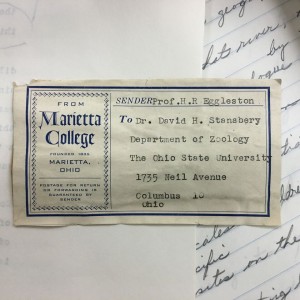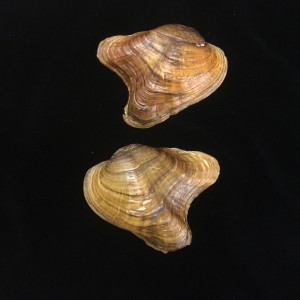What did the once hidden collections contain?
The Hildreth Collection contained a total of 84 different species of freshwater molluscs, 64 of which were from the Ohio River System, 12 from other river systems, and 8 specimens from other places around the globe such as France.

The original shipping label for the Hildreth and Holden collections as sent to Dr. David H. Stansbery, emeritus Curator of Molluscs, from H.R. Eggleston.
In 1828, Hildreth published his Observations on, and Descriptions of the Shells found in the Waters of the Muskingum River, Little Muskingum and Duck Creek in the vicinity of Marietta in the American Journal of Science Vol. XIV, 1828. In it Hildreth wrote about the abundance and distribution of twenty-six species of the molluscs found in Marietta Ohio. Luckily some of the text clearly references parts of his actual collection, and it was possible to figure out the original shell’s location by comparing the two.
The most interesting part of Hildreth’s 1828 publication is where he wrote about a species called Dysnomia foliata, now known as Epioblasma flexuosa. This particular species, according to the notes and letters he left behind (as well as the many specimens he sent to other collections all over the USA), was relatively abundant. It is now extinct and no one has seen it since around 1900. How did something once so abundant disappear? Maybe someone will eventually figure it out…
How do we know when the specimens were collected?
As Hildreth added specimens to the collection, he recorded the scientific names for each of them. Scientific names often change over time as new taxonomic research is done and new methods become available. Thus a particular scientific name for a species can be used as a time stamp and, in this case, allowed us to estimate a date range for collection.

One of the papers left behind by Dr. David H. Stansbery regarding his study of the collection. This is his tally of the dates that species names were being used.
When all the names in the Hildreth collection where tallied up by Dr. David H. Stansbery, emeritus Curator of Molluscs, the story became clearer: The absolute most recent name, Quadrula fragosa, was from 1835. It is, therefore, likely that the collection itself ends a few years after that. My best guess, after going through the Marietta College database of his collected correspondence, is that the collection was set aside in 1840. That is the date when his letters stop mentioning shell exchanges and instead start focusing on geological coal surveys. I also found the first mention of a shell exchange in a letter in 1824. This indicates that, to the best of our current knowledge, the collection was made over a time-span of around 15 years.
The Holden Collection was the smaller collection of the two, made by a Mr. William Holden. It consists of either one or a few collection events from the Ohio River at Marietta in the year 1879. The Holden collection, therefore, constitutes a very rare look at the nature of the Ohio River naiad (freshwater mussel) fauna of that region between the time of Dr. Samuel P. Hildreth (1825-1840) and the time of Dr. Arnold E. Ortmann (1900-1927).

A letter from 1977 found among the documentation relating to the collections.
Ortmann, in his monograph on the Naiads of Pennsylvania, lists records of all Ohio River species of Pennsylvania present in the Carnegie Museum, but does not seem aware of the existence of the Holden Collection. This makes sense, if the collection had been sealed up in a wall between that time and WWII when it was finally discovered.
It does certainly look like this collection’s story has been told before, but unfortunately everyone I tried to track down in reference to it has long since passed away.
About the author: Sara Klips is still the Mussel Fairy and wishes more people realized how engaging shell bound mollusks can be. She hopes that you know that the “eye stalks” on slugs are called tentacles, and that you realize that filmy plastics can never be put in the recycling bin.
